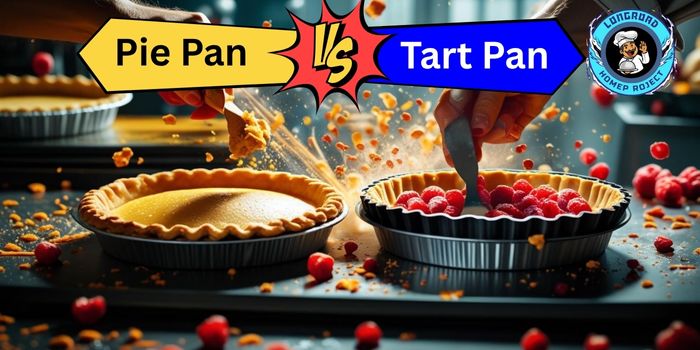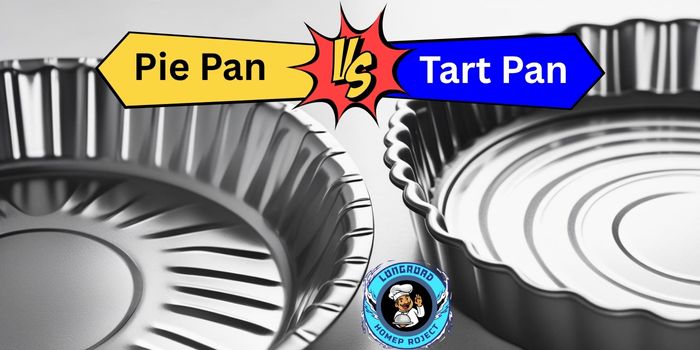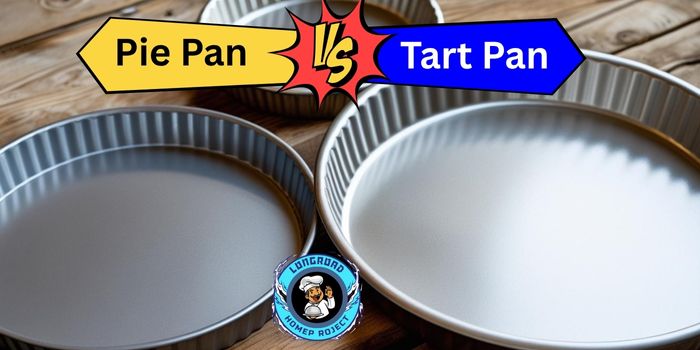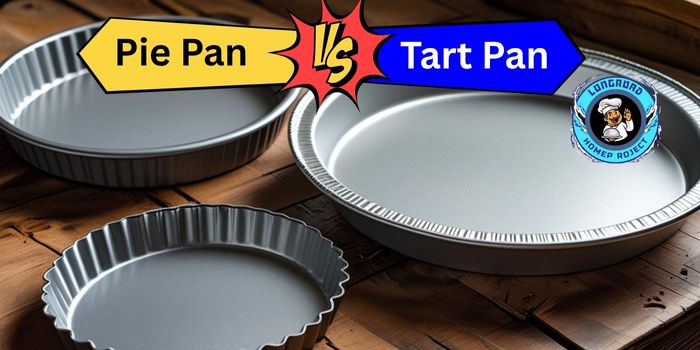As an Amazon Associate I earn from qualifying purchases.
I once used a pie pan for a tart—and it wasn’t pretty. The crust sagged, the edges lost all shape, and the filling? Let’s just say it pooled more than it set. That baking experiment taught me a valuable lesson: not all pans are created equal, especially when it comes to presentation and texture.
So, if you’ve ever wondered whether you really need a tart pan or if your trusty pie dish can do double duty, you’re not alone. The pie pan vs tart pan debate is one every home baker runs into eventually—and choosing the right one can make all the difference between “meh” and “masterpiece.”
At a glance, they may seem similar: both are round, made for desserts, and sit quietly in your cabinet most of the year. But dig deeper, and you’ll find that their structure, design, and function are surprisingly different. Tart pans have sharp, straight sides and removable bottoms for a flawless release. Pie pans? They’re deeper, curved, and built for buttery, flaky comfort food.
In this guide, I’ll break down everything you need to know about tart pans, pie pans, their substitutes, and when it actually matters which one you use. Whether you’re baking a rustic apple pie or a polished lemon tart, this post will help you bake smarter—with fewer messes and better results.
Let’s get into it, pan by pan.
Pie Pan vs Tart Pan – What’s the Difference?
Design & Shape Comparison
When it comes to baking, the pan you use can make or break your dessert. The debate of pie pan vs tart pan often comes down to design and function. At a glance, the most obvious difference is in their shape: pie pans have sloped edges, while tart pans feature straight, fluted sides that create sharp, elegant edges.
Pie pans are designed for volume, typically deeper and slightly angled to hold juicy fillings like apples, berries, or pumpkin. Their depth ranges from 1 to 1.5 inches, with diameters commonly around 9 inches. These gently sloping sides help support the weight of thicker, softer crusts and fillings.
On the flip side, tart pans usually have shorter sides and a more precise diameter. They’re made for delicately layered desserts, where presentation matters. Tart pans are known for their removable bottoms, which allow you to lift the tart out cleanly without damaging the crust—a feature not found in traditional pie pans.
So, whether you’re going for a rustic slice of warm apple pie or an elegant lemon tart with razor-sharp edges, your pan shape plays a critical role in how your dessert turns out.
Material Breakdown
The material of your bakeware impacts everything from how evenly your crust bakes to whether your tart releases in one piece. Both pie pans and tart pans come in a variety of materials including aluminum, ceramic, glass, and steel.
- Aluminum is lightweight and known for conducting heat evenly, making it great for consistent browning.
- Glass allows you to monitor doneness through the bottom, a handy feature for beginners.
- Ceramic offers a beautiful presentation and retains heat well, ideal for serving at the table.
- Steel or carbon steel (often with a non-stick coating) is the most common for tart pans, thanks to their crisping abilities and removable bases.
Each material responds differently to heat. For instance, a glass pie pan might need a longer bake time but gives you a golden crust, while a steel tart pan can deliver a crisp crust faster but requires careful handling to prevent sticking.
Understanding how your bakeware material interacts with your oven can elevate your baking results dramatically. Whether you’re going for a crunchy pâte sucrée base or a buttery, flaky pie crust, your choice of material matters.
Real Use Case Comparison
Let’s get into the nitty-gritty: what are these pans really built to do?
Pie pans are your go-to for classic, deep-dish desserts. Think apple pie, pecan pie, or chicken pot pie. The sloped sides not only hold more filling but also support doughs that tend to shrink or slump. They’re built for comfort food—hearty, warm, and usually served straight from the pan.
Tart pans, by contrast, are about refinement. Their low sides and fluted edges help create perfectly even crusts that hold their shape beautifully. They’re typically used for recipes with structured crusts like shortcrust pastry or pâte sucrée, which don’t puff or slump when baked. From fruit tarts to savory quiches, the design helps deliver a crisp shell that contrasts nicely with creamy or custard-style fillings.
So, if you’re baking something like a custard tart or French-style quiche, a tart pan is ideal. But for gooey, fruit-filled pies or comfort bakes, stick with a classic pie dish. Each pan serves its purpose, and knowing when to use which can take your baking from good to great.

Pie Pan Substitute – What Works in a Pinch?
Can you use a pie pan for a tart? Technically, yes — but it’s not a one-to-one swap. I’ve done it in a pinch, and while the results were tasty, the presentation didn’t quite match the finesse of a proper tart. Let’s break down what to expect and what you can do to get the best results.
Adjusting Your Recipe and Expectations
The biggest issue with using a pie pan as a tart pan is the depth and shape. Tart pans are shallow with straight, fluted edges and often have removable bottoms for easy release. Pie pans, on the other hand, have sloped sides and are usually deeper, which affects both the crust and the filling.
If you’re using a pie pan for a tart:
- Cut down on filling to avoid overbaking the crust
- Chill your dough well to help it keep shape against the sloped sides
- Blind bake the crust to avoid sogginess, especially for custard or cream-based tarts
It’s doable — just don’t expect those crisp, Instagram-worthy fluted edges.
Creative Pie Pan Substitutes That Work
If you’re in the middle of a bake and realize your tart pan is MIA, try one of these:
- Quiche Pan
Similar in structure to tart pans, and many have removable bottoms. Great for both savory and sweet tarts. - Springform Pan
Excellent for deep-dish tarts or tortes. Bonus: easy removal and pretty sides. Just line the bottom to prevent leaks. - Cake Pan with DIY Fluting
Line the inside edge with a strip of folded foil or parchment to mimic the straight sides of a tart pan. Works better than it sounds! - Foil Hacks: Make a Tart Ring
Fold heavy-duty foil into a sturdy ring and place it on a parchment-lined baking sheet. Pour in the dough and press it up against your DIY mold. Works in emergencies and gives you that signature flat-bottom tart shape.
Related Comparisons: Quiche, Torte, and More
It’s easy to get confused with so many pan types that look similar. Let’s clear things up.
Quiche Pan vs Pie Pan
They might look interchangeable, but there are key differences.
- Quiche pans are typically shallow, fluted, and often have removable bottoms — just like tart pans. They’re ideal for egg-based dishes like quiches and custards that need a firm base and even cooking.
- Pie pans are deeper and built for more liquid-heavy or fruit-based fillings. Their sloped sides help the crust support that extra volume.
Bottom line: You can bake a quiche in a pie pan, but you’ll need to reduce the filling and watch the bake time.
Torte Pan vs Tart Pan
A torte pan is often confused with a tart pan, but they’re typically deeper and sometimes lack the removable base. Tortes are more like dense cakes or layered desserts — think of them as pastry’s hybrid cousin.
- Tart pans offer that elegant, crisp edge and are designed for delicate crusts like pâte sucrée or pâte brisée.
- For tortes, a springform pan is often the better fit because it handles weight and volume well.
If you’re going for structure and edge detail, stick with a tart pan. For layered, denser desserts, go with the springform.
Quiche Dish vs Pie Dish
Now we’re into material territory. A quiche dish is typically made of ceramic or stoneware, which holds heat well and bakes more evenly at a slower pace. Great for silky egg bakes.
A pie dish might be ceramic, glass, or metal — and each material changes how the crust bakes:
- Glass lets you see doneness
- Metal browns fast
- Ceramic gives a slower, more even bake
Use a quiche dish when presentation and gentle heat matter. Stick to a pie dish when you need versatility and crisp bottoms.

What I Learned from Baking with the Wrong Pan
Let me tell you a quick story — one that ended in a sticky oven and a soggy crust.
I once tried making a lemon tart in a standard glass pie dish because my tart pan was nowhere to be found. I figured, “Hey, what’s the worst that could happen?”
Well…
The crust slumped down the sloped edges.
The filling overflowed.
And the result? A misshapen, overbaked lemon puddle with burnt sugar drips on the bottom rack of my oven.
The flavor? Still good.
The cleanup? Not so much.
Lesson learned: The right pan isn’t a luxury — it’s part of the recipe.
If you’re serious about baking tarts, invest in a good tart pan with a removable bottom. It makes all the difference in structure, texture, and presentation. You’ll thank yourself every time the crust slides out clean and perfect.
When You Should Definitely Use a Tart Pan
Tart pans aren’t just about aesthetics — they serve a real baking purpose. If your recipe involves any of the following, don’t even think about grabbing a pie dish.
Delicate Crusts
Sweet pastry doughs like pâte sucrée or shortbread crusts are fragile by nature. They need the straight sides and shallow depth of a tart pan to hold their shape without slumping.
Recipes Requiring Presentation
Those fluted edges do more than look pretty. They help set the crust’s structure and give a polished finish that’s ideal for:
- Dinner parties
- Holidays
- Instagram-worthy dessert shots
Presentation matters — and tart pans deliver.
Easy Removal is a Must
Ever tried scooping a tart out of a pie pan? Disaster.
That removable bottom on a tart pan is a lifesaver, especially for:
- Custard tarts
- Chocolate ganache tarts
- Anything delicate or sticky
It releases the tart with no cracking, no digging, and no heartbreak.
Best for These Recipes:
- Fruit or custard tarts
- Savory quiches
- Mini tartlets or tartlet shells (use mini tart pans!)
- Press-in crusts that don’t need blind baking

When a Pie Pan Is the Better Choice
Now, don’t toss your pie pan just yet. It’s still a kitchen essential — just in a different way.
Juicy Fruit Fillings
Apple, cherry, blueberry — all those juicy fruit pies need the depth of a pie pan to contain the moisture without spilling over. The sloped sides help contain bubbling fruit and thickened juices.
Double-Crust or Lattice-Topped Pies
Tart pans aren’t designed for top crusts. You need that extra vertical room and structure that pie pans provide for:
- Traditional double-crust pies
- Lattice-topped beauties
- Pot pies with a thick pastry seal
Dishes That Need Deep Volume
Think of the pie pan as the heavyweight champ. If you’re making something rich, dense, or heaping with filling — like a deep-dish pecan pie or a meat pie — a tart pan just won’t cut it.
Pro Tip: Use your pie pan for anything that oozes, bubbles, or needs a solid pastry wall for support. Use your tart pan for anything that’s meant to look elegant and behave well under heat.
Enameled Tart Pans, Ceramic Pie Plates & Beyond
The world of bakeware has come a long way from basic aluminum. If you’ve been eyeing those glossy ceramic pie dishes or colorful enameled tart pans on Instagram or in artisan kitchen shops — you’re not alone.
Here’s why these upgraded pans are worth considering and how they perform in real baking scenarios.
Why Enameled and Ceramic Pans Are Trending
- Aesthetic appeal: These pans are beautiful enough to go from oven to table — no need to transfer your tart to a serving dish.
- Heat retention: Ceramic holds heat exceptionally well, keeping your pies warm longer at the table.
- Non-toxic and natural: Enameled and ceramic coatings are often free from Teflon or chemical coatings.
- Durability: When cared for properly, these pans can last for decades.
They’re not just “pretty pans” — they’re performance tools with a side of style.
🧡 Best Brands and Bakeware Options
Here are a few top-rated options bakers swear by:
- Emile Henry (France) – Iconic for their glazed ceramic pie dishes
- Le Creuset – Offers enameled stoneware tart and pie pans in vibrant colors
- Staub – Known for their heavy-duty enameled cast iron bakeware
- USA Pan – Trusted metal tart pans with fluted edges and removable bottoms
- Wilton & Nordic Ware – Great budget options for beginners
💡 Tip: If you’re buying online, read real customer reviews for insight on ease of release, staining, and cleanup.
What to Look for in a Quality Tart or Pie Pan
No matter your style, these key features matter:
- Even heating: Avoid pans that warp or cause hot spots.
- Removable bottom (for tarts): Ensures clean release every time.
- Depth and diameter: Match your pan size to your go-to recipes.
- Nonstick surface or easy-release glaze: Makes cleanup painless.
- Oven-safe to 450°F+: Essential for high-temp baking.
If possible, invest in at least one metal and one ceramic pan to suit different recipes.
Oven Safety, Cleanup, and Longevity
- Avoid thermal shock: Never go from fridge to hot oven with ceramic or enamel.
- Hand wash only: Most premium pans last longer without dishwasher use.
- Store with care: Stack with padding or store separately to avoid chips.
- Preheat with the oven: Don’t place empty ceramic pans in a hot oven to avoid cracking.
In short: treat these pans well, and they’ll repay you in pie crusts that brown evenly and release beautifully.

FAQs
❓ Can you use a pie pan for a tart?
✅ Yes, but expect a different crust structure and less detail. Use foil to mimic straight sides.
❓ What’s the best substitute for a tart pan?
✅ A quiche pan or springform pan works best. You can also use a cake pan with care.
❓ What’s the difference between a quiche pan and a pie pan?
✅ Quiche pans are shallower with fluted edges and removable bottoms. Pie pans are deeper and more versatile.
❓ Does pan material matter when baking pies or tarts?
✅ Absolutely! Glass, metal, or ceramic each affect browning and baking time differently.
❓ Is a torte pan the same as a tart pan?
✅ Not quite. Torte pans are deeper and often springform style. Tart pans are shallow with fluted sides.
Conclusion
So, pie pan vs tart pan—which one deserves a spot in your kitchen?
Let’s recap the key takeaways:
🔹 Pie pans have sloped sides, deeper wells, and are perfect for juicy fruit fillings, double-crust classics, and anything requiring volume.
🔹 Tart pans offer sharp fluted edges, removable bottoms, and are best for shortcrusts, custards, and elegant presentations.
🧁 My Honest Take:
- If you bake regularly? Keep both. Each has its specialty, and having the right tool makes baking easier and more enjoyable.
- If you’re a casual or beginner baker? Start with a classic metal or glass pie pan. It’s the most versatile option for pies, quiches, and even rustic tarts.
- Want to level up? A tart pan is an affordable upgrade that instantly makes your desserts look bakery-worthy.
🎯 Final Encouragement:
Don’t overthink it. Even if your tart slumps a bit or the crust cracks, it’s all part of the learning process. And let’s be real — a slightly imperfect tart still tastes absolutely amazing.
So bake boldly, experiment often, and enjoy every flaky, buttery bite.
As an Amazon Associate I earn from qualifying purchases.
